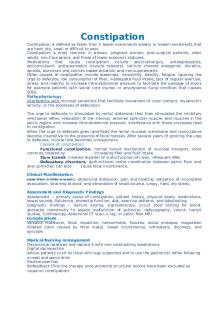Focused GI Assessment - this id helpful for skills practice PDF

| Title | Focused GI Assessment - this id helpful for skills practice |
|---|---|
| Course | Fundamentals of Nursing |
| Institution | Howard Community College |
| Pages | 4 |
| File Size | 157.9 KB |
| File Type | |
| Total Downloads | 99 |
| Total Views | 135 |
Summary
this id helpful for skills practice...
Description
When conducting a focused gastrointestinal assessment on your patient, both subjective and objective data are needed. Components may include:
Chief complaint Present health status Past health history Current lifestyle Psychosocial status Family history Physical assessment
-
Communication during the history and physical must be respectful and performed in a culturally sensitive manner. Privacy is vital, and the healthcare professional needs to be aware of posture, body language, and tone of voice while interviewing the patient Take into consideration that a patient’s ethnicity and culture may affect the history that the patient provides.
-
Taking a Focused Gastrointestinal History You will need to elicit information about any complaints of gastrointestinal disease or disorders manifestations such as
Change in appetite Weight gain or loss Dysphagia Intolerance to certain foods Nausea and vomiting Change in bowel habits Abdominal pain
Past Gastrointestinal Disease and Medication History Ask about any past history of gastrointestinal disorders such as ulcers, gall bladder disease, hepatitis, appendicitis, hernias. Ask the patient if they received treatment and if the treatment was successful. History should also include past abdominal surgeries, any abdominal problems after the surgery, and abdominal x-rays or tests (including colonoscopy) and their results Aspirin and non-steroidal anti-inflammatory drugs (NSAIDs) may cause abdominal pain and may increase the likelihood of gastrointestinal bleeding. Dietary supplements and the use of over the counter medications should also be included
Social History and Lifestyle Risk Factors Ask your patients about the frequency and duration of alcohol consumption, caffeine intake, and cigarette smoking at this time. Alcohol can cause liver cirrhosis and esophageal varices. Cigarette smoking and regular ingestion of caffeine can lead to gastric reflux and gastric ulcers. Also ask about recreational drug use such as marijuana, opiates, or amphetamines. The use of illicit drugs can increase or suppress appetite and affect GI function ( Nutritional Assessment Assessing nutritional status of your patients is important for several reasons. A thorough nutritional assessment will identify individuals at risk for malnutrition and provide baseline information for nutritional assessments in the future. The Physical Exam When performing a focused assessment, you will use at least one of the following four basic techniques during your physical exam: -
inspection, auscultation, percussion, and palpation.
These techniques should be used in an organized manner from least disturbing or invasive to most invasive to the patient. Inspection is first, as it is non-invasive. Auscultation is performed following inspection; the abdomen should be auscultated before percussion or palpation to prevent production of false bowel sounds. For accurate assessment of the abdomen, patient relaxation is essential. The patient should be comfortable with knees supported and arms at the sides and should have an empty bladder. The environment should include a comfortable temperature, with good light. Table of Bowel Sounds
Abdominal Pain If your patient is experiencing abdominal pain, have them point to the exact location of the pain. Abdominal pain can be classified as: • Visceral • Parietal • Referred Visceral Pain Visceral pain is usually described as dull, crampy, squeezing, or aching. It can be constant or intermittent. The pain may be difficult to localize orand may be located over an abdominal organ Parietal Pain Parietal pain is usually from inflammation over the peritoneum. Peritoneal inflammation usually indicates an underlying emergency and should be assessed quickly. Parietal pain is usually intense, constant, and on one side. It can be aggravated by extension of the lower extremity on the affected side, coughing, or eliciting rebound tenderness Referred Pain
Referred pain is usually visceral pain that is felt in another area of the body when a common nerve pathway is shared. It occurs with specific gastrointestinal disorders such as appendicitis (can cause umbilical pain in early stages), gall bladder disease (referred to right upper scapula), and pancreatitis (referred to the mid-back)...
Similar Free PDFs

Lower GI Practice Questions
- 5 Pages

Diosdado Macapagal - This is helpful
- 24 Pages

Module 6 - GI GU Assessment
- 29 Pages

Joseph estrada - This is helpful
- 20 Pages

Helpful practice qns
- 7 Pages

Map Skills Assessment
- 6 Pages

Med Surg GI practice questions
- 23 Pages
Popular Institutions
- Tinajero National High School - Annex
- Politeknik Caltex Riau
- Yokohama City University
- SGT University
- University of Al-Qadisiyah
- Divine Word College of Vigan
- Techniek College Rotterdam
- Universidade de Santiago
- Universiti Teknologi MARA Cawangan Johor Kampus Pasir Gudang
- Poltekkes Kemenkes Yogyakarta
- Baguio City National High School
- Colegio san marcos
- preparatoria uno
- Centro de Bachillerato Tecnológico Industrial y de Servicios No. 107
- Dalian Maritime University
- Quang Trung Secondary School
- Colegio Tecnológico en Informática
- Corporación Regional de Educación Superior
- Grupo CEDVA
- Dar Al Uloom University
- Centro de Estudios Preuniversitarios de la Universidad Nacional de Ingeniería
- 上智大学
- Aakash International School, Nuna Majara
- San Felipe Neri Catholic School
- Kang Chiao International School - New Taipei City
- Misamis Occidental National High School
- Institución Educativa Escuela Normal Juan Ladrilleros
- Kolehiyo ng Pantukan
- Batanes State College
- Instituto Continental
- Sekolah Menengah Kejuruan Kesehatan Kaltara (Tarakan)
- Colegio de La Inmaculada Concepcion - Cebu








